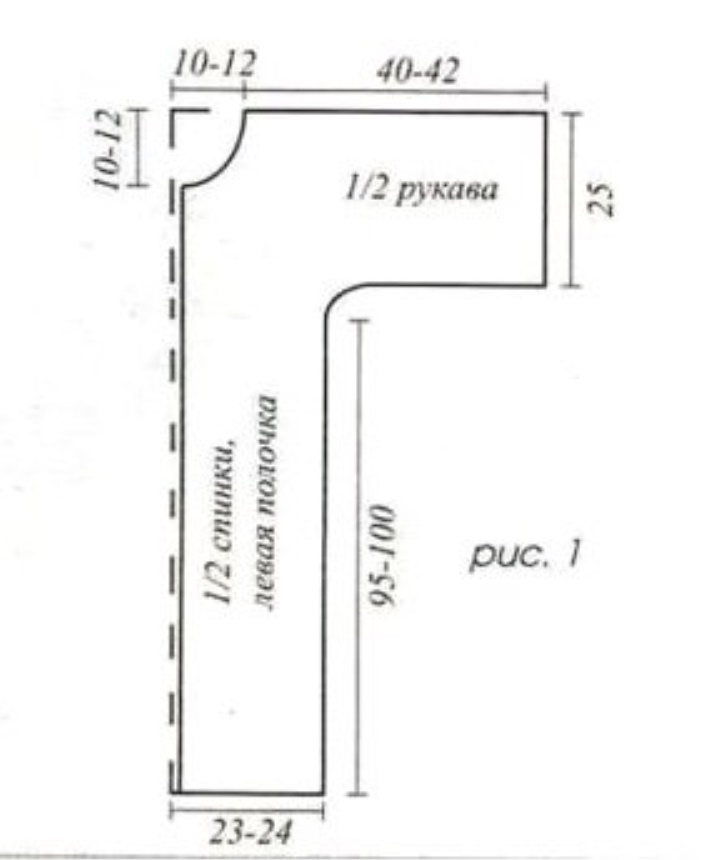
Knitting a coat will require 1000 - 1100 g of bulk yarn in coffee-and-milk color, needles No. 4.5-5; 5-6 buttons on the leg.
Facial smoothness . One of the most popular techniques for making knitted fabric. Simple to perform, but very insidious in behavior. It must be remembered that the edges of the canvas, made the front satin twist both horizontally and vertically.
But experienced craftswomen know how to eliminate these shortcomings.
Patterns of weaves have always attracted masters of their complexity. The intricate interweaving of harnesses and braids allows experienced craftswomen to fantasize when creating one or another pattern.

Another technique that the author used when performing this model is a knotted edge. One of the edge loops, and both can be knit, not with a purl loop as is customary, but with a face loop. This allows you to get knots on the edge of the part. Besides the fact that the edge becomes more rigid, it becomes more decorative.
When making models of thick yarn, this edge allows you to stitch parts together, and this, in turn, allows you to avoid bulk and uncomfortable seams.
Before you begin, complete the reference sample. This is necessary to calculate the required number of loops. Use the pattern shown in Fig. 1. It would be better, of course, if you build a pattern according to individual sizes.
Description of knitting a coat with needles:
For the back, type 100 loops on the knitting needles (the author's value is adjusted in accordance with the knitting density) and knit 2 rows with the front satin stitch. Then continue the work of the purl.
Perform 2 rows and go back to the front surface.
Continue work alternating 2 rows of the front surface and 2 rows of the back surface. After repeating the looping change 16 times, continue to work with the facial surface.
After completing 95-100 cm (autorot value) from the beginning of knitting, for the sleeves, add 5 times, 2 loops on both sides in each 2nd row. Then add at the same time 30-35 loops (author's value) in each 2nd row. Keep working on all the hinges.
After completing 25 cm (author value) from the last addition of loops, close them.
For the left shelf, type 50 loops (author's value) and knit 32 rows, a string between 2 rows of the front surface and 2 rows of the back surface. Then distribute the loops as follows: edge loop, 2 face loops, 24 loops according to the scheme 1, 22 face loops, edge loop. After knitting 95-100 cm (author value) from the beginning of knitting, for the sleeve, add 5 loops on the left 2 times in each 2nd row. Then add on the left side at the same time 30-35 loops (author's value) in each 2nd row. Keep working on all the hinges.
After completing 25 cm (author value) from the last addition of loops, close them.
Knit the right shelf symmetrically left. When distributing loops, use scheme 2.
For the cuff, type 30 loops (author value). Continue to work according to scheme 3.
Knit one of the edge loops (first or last) with a face loop. After completing 38-40 cm (the author's value) from the beginning of work, close all the loops.
For the collar, type 30 loops (the author's value) and knit 2 rows with a purl. Then proceed to work on scheme 3. After completing 37-39 cm (author's value) from the beginning of knitting, perform 2 rows of purl, and then close all the loops.
Build a coat: Perform shoulder and side seams. Sew the cuffs, placing a bow fold in the shoulder seam area (2-2.5 cm on each side). Note that the knotted edge should be on the edge of the cuff.
Along the edges of the shelves perform finishing strips. To do this, type the loop and knit 2-3 rows of purl. Do not forget to make buttonholes on the right shelf. Sew a collar along the neckline. Tie the buttons and sew them.
Source :
https://www.liveinternet.ru/users/3803925/post441594342/